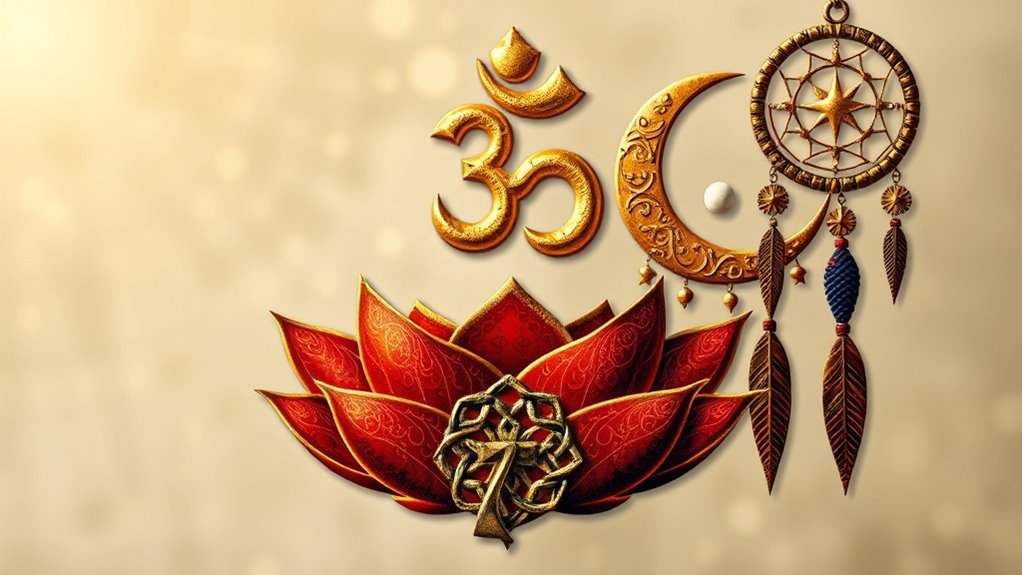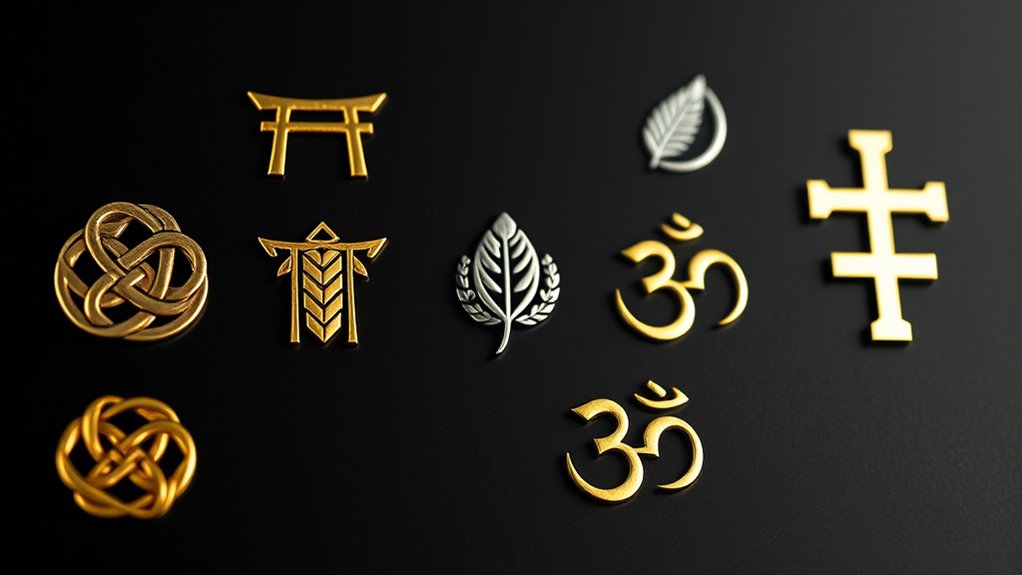Cross-cultural symbols in iconography highlight how universal human themes and spiritual beliefs are expressed visually across different societies. These symbols often have origins thousands of years old and embody concepts like life, death, and transformation. Their meanings evolve and adapt through cultural exchange, creating rich, layered interpretations. Understanding these symbols helps you appreciate their cultural significance and common roots. Exploring this fascinating topic further reveals the deep connections behind visual storytelling across the world.
Key Takeaways
- Cross-cultural symbols often originate from universal human themes like life, death, and transformation, appearing independently across societies.
- They serve spiritual and religious purposes, representing divine concepts, cosmic order, and communal identity in diverse cultures.
- Symbols adapt over time through cultural exchange, leading to reinterpretations that can shift or expand their original meanings.
- Cultural context influences symbol interpretation, making awareness of regional nuances essential to prevent miscommunication.
- Thoughtful integration of cross-cultural symbolism in design fosters authenticity, respect, and broader appeal in global branding.
The Origins and Universal Roots of Iconic Symbols

Many of the symbols we see today share deep roots that cross cultural boundaries, reflecting universal human experiences. Their historical origins trace back thousands of years, often appearing independently in different societies. These symbols embody universal symbolism, representing concepts like life, death, fertility, or protection. For example, the circle symbolizes eternity in many cultures, while the spiral often signifies growth or transformation. Recognizing these common themes reveals how humans across time and space have used visual language to communicate essential ideas. The color temperature of a symbol’s depiction can also influence how it is perceived across cultures, highlighting its universal appeal. Additionally, the cultural significance of symbols can vary, yet their core meanings often resonate similarly across societies. Understanding the historical origins of these symbols helps us appreciate their enduring relevance. Many of these symbols are also linked to universal human values, which further emphasizes their cross-cultural importance. By understanding the origins of these symbols, you gain insight into shared human values and concerns. This universal symbolism highlights how, despite diverse cultural expressions, many symbols serve similar fundamental purposes—connecting us through collective human experience. In the context of Cultural Intelligence, recognizing these shared symbols can enhance cross-cultural understanding and communication.
Symbols of Spirituality and Religious Significance Across Cultures

Symbols of spirituality and religious significance appear across cultures because they serve as powerful tools for expressing the intangible aspects of faith, divine presence, and cosmic order. Sacred rituals often incorporate specific symbols that evoke spiritual truths and connect practitioners to higher powers. Religious iconography provides visual representations of divine figures, sacred concepts, and spiritual ideals, making complex beliefs more tangible. These symbols help followers communicate devotion, seek protection, or mark spiritual milestones. Whether it’s a sacred lotus, a cross, or a mandala, each carries deep meaning rooted in its cultural context. They foster communal identity and reinforce shared spiritual values, transcending language barriers and uniting believers through visual language that embodies divine essence. Additionally, understanding the cultural significance of these symbols enhances appreciation for their role in fostering spiritual unity and identity across diverse traditions. Recognizing the symbolic meanings behind various motifs can deepen one’s connection to spiritual practices and cultural heritage. Exploring how energetic alignment influences the interpretation of symbols can reveal new layers of spiritual insight and personal growth. Moreover, studying the symbolic evolution over time can provide insights into how these symbols adapt and resonate within evolving cultural landscapes. This ongoing transformation underscores the universal human tendency to find meaningful representations that bridge the material and spiritual worlds.
Visual Metaphors: How Cultural Context Shapes Symbol Interpretation

Cultural context profoundly influences how visual metaphors are interpreted, shaping the way symbols convey meaning across different societies. Mythical narratives often serve as rich sources of artistic symbolism, providing layered metaphors that resonate uniquely depending on cultural background. For example, a serpent might symbolize wisdom in one culture but danger or evil in another. Your understanding of these metaphors depends on the stories and beliefs ingrained in your society. Artistic symbolism draws on these narratives to communicate complex ideas visually, but their interpretation varies widely. Recognizing how cultural context shapes these visual metaphors allows you to appreciate the depth behind symbols and avoid misinterpretations. It’s through this lens that you see how society’s myths influence the way symbols are perceived and understood. Additionally, the diverse designs of planters, ranging from quirky shapes to recycled materials, exemplify how cultural influences can extend beyond symbolism into aesthetic preferences and material choices. Furthermore, understanding the role of symbolism in different cultures enhances your ability to interpret art and design with cultural sensitivity. Moreover, awareness of AI’s influence on cultural symbols can help you see how emerging technologies shape modern interpretations of traditional imagery.
Adaptation and Evolution of Symbols in a Globalized World

In a globalized world, symbols continuously adapt as cultures interact and exchange ideas. Cultural adaptation plays a crucial role in how symbols evolve, allowing them to resonate across different societies. When you encounter a symbol from one culture adopted into another, you see its meaning shift or expand, reflecting new contexts and values. This symbol evolution often involves simplifying, combining, or reinterpreting elements to suit diverse audiences. As cultures blend, symbols lose their original exclusivity and gain broader significance, fostering shared understanding. You might notice traditional symbols transforming into modern icons, maintaining core meanings while adapting to contemporary needs. This ongoing process highlights how cultural exchange drives the dynamic evolution of symbols, ensuring they remain relevant and meaningful in an interconnected, global landscape. Additionally, the influence of research-based personality assessments demonstrates how understanding individual and cultural differences can shape symbol interpretation and adaptation. Recognizing cultural symbolism helps explain how symbols maintain relevance across diverse groups while evolving in meaning over time. Furthermore, symbolic adaptation often reflects broader societal changes, such as technological advances or shifting moral values, which influence how symbols are perceived and utilized. For example, the visual language of symbols frequently transforms as societies modernize, reflecting changing priorities and worldviews. It is also important to consider how historical context impacts the way symbols are interpreted and redefined across generations.
Cross-Cultural Symbols in Modern Design and Branding

As brands seek to connect with diverse audiences, they increasingly incorporate cross-cultural symbols into their modern designs and branding strategies. Mythical motifs, like dragons or phoenixes, evoke universal ideas of strength, renewal, and protection, resonating across cultures. Color symbolism also plays an essential role; for example, red can signify luck in China and passion in Western contexts. By blending these symbols thoughtfully, you create visuals that appeal broadly while respecting cultural nuances. Incorporating these elements into logos, packaging, and advertising helps brands stand out in a crowded market. Understanding the significance of symbolic meanings can deepen the cultural relevance of your branding efforts. Additionally, considering cultural symbolism during the design process ensures that visual elements are both meaningful and respectful. Recognizing the importance of holistic health and emotional connection in branding can further enhance consumer engagement. Ultimately, understanding and leveraging cross-cultural symbols enhances your brand’s global appeal and demonstrates cultural awareness, which can also improve insulation techniques in design to protect cultural integrity. Developing a nuanced understanding of cultural context enables designers to create more authentic and respectful visual narratives in multicultural markets.
Challenges and Opportunities in Interpreting Transcultural Iconography

Interpreting transcultural iconography presents unique challenges, especially when cultural contexts differ or overlap. You might encounter ambiguous symbols whose meanings vary across regions, making interpretation tricky. A new sentence with traditional churns and the rest of the sentence. At the same time, you have opportunities to foster cross-cultural understanding by thoughtfully managing sensitivities and diverse perspectives. Incorporating textile art techniques can also serve as a visual language that bridges cultural differences, enriching the interpretive process.
Cultural Context Variations
Understanding transcultural iconography requires recognizing how cultural contexts shape the meanings of symbols. Different linguistic variations can influence how symbols are interpreted, making some images feel familiar in one culture but obscure in another. Regional symbolism also plays a vital role; a symbol representing prosperity in one area might signify mourning elsewhere. You need to be aware that these variations can lead to misunderstandings if you assume symbols have universal meanings. At the same time, they offer opportunities for deeper engagement—by exploring local nuances, you can uncover richer interpretations. Recognizing these cultural context differences helps you approach iconography with sensitivity and accuracy, ensuring that your interpretations respect the diverse backgrounds that give symbols their unique significance. Additionally, understanding cultural symbolism can enhance cross-cultural communication and foster mutual appreciation.
Symbol Meaning Ambiguity
Cultural differences don’t just influence how symbols are interpreted—they can also create significant ambiguity. This ambiguity stems from interpretation flexibility and meaning multiplicity, which can lead to varied understandings across cultures. You might see a symbol as positive in one context but offensive in another. Recognizing this complexity helps you navigate transcultural iconography more thoughtfully. Consider these points:
- Symbols may carry different meanings depending on cultural context
- Interpretation flexibility allows for diverse, sometimes conflicting, understandings
- Meaning multiplicity can enrich or complicate communication
- Misinterpretations can occur without awareness of cultural nuances
Navigating Cultural Sensitivities
Managing cultural sensitivities in iconography requires careful awareness of diverse perspectives and potential missteps. You must recognize that symbols can be misunderstood or offend if cultural contexts aren’t considered. Developing sensitivity strategies helps prevent cultural misinterpretations and fosters respectful exchanges. Consider the following factors:
| Factor | Impact |
|---|---|
| Cultural Context | Shapes symbol meaning and perception |
| Historical Significance | Influences interpretations and sensitivities |
| Religious Associations | Affects acceptance and potential offense |
| Local Norms | Determine appropriateness and reception |
Frequently Asked Questions
How Do Symbols Maintain Their Meanings Across Vastly Different Cultures?
You might wonder how symbols keep their meanings across different cultures. By sharing cultural histories, communities develop common understandings, making symbols meaningful beyond borders. Visual context also plays a key role; when people see symbols in familiar settings, they interpret them similarly. Your awareness of these factors helps you see how symbols can transcend cultural differences, acting as universal connectors rooted in shared experiences and visual cues that shape their ongoing significance.
What Role Do Language Barriers Play in Symbol Interpretation?
Think of language barriers as a double-edged sword that can cut both ways. They often lead to linguistic misunderstandings, making it harder for you to interpret symbols accurately. Cultural translation becomes tricky when words don’t carry the same meaning across languages, causing confusion or miscommunication. You might find yourself lost in translation, missing the true essence of symbols, which underscores how crucial clear communication is in understanding different cultural contexts.
Can Symbols Have Negative or Unintended Connotations in Other Cultures?
You should be aware that symbols can carry negative or unintended connotations in other cultures, leading to cultural misinterpretations. What seems positive or neutral in one society might evoke negative symbolism elsewhere. This can cause misunderstandings or offend people, especially if you’re unaware of these differences. To avoid issues, research the cultural significance of symbols before using them, ensuring your message is respectful and appropriate across diverse communities.
How Does Digital Media Influence Cross-Cultural Symbol Dissemination?
Digital media acts like a global river, flowing rapidly and carrying symbols across borders. You can see how digital platforms and social sharing turn local icons into worldwide signals, shaping perceptions and understanding. As you share and scroll, these symbols transform, connecting diverse cultures. This fast-paced exchange amplifies their reach but also risks misinterpretation, making it essential for you to contemplate how symbols might resonate differently across cultural landscapes.
Are There Universal Symbols Recognized by All Cultures Globally?
You might wonder if there are universal symbols recognized by all cultures. While some symbols, like the peace sign or smiley face, serve as shared cultural references, many others evolve over time, reflecting changing meanings and contexts. Symbol evolution occurs as cultures adapt symbols to fit their unique identities, making true universality rare. Still, certain symbols resonate globally, bridging cultural gaps through their simple visual language.
Conclusion
You can see how cross-cultural symbols act like shared languages, bridging gaps between diverse worlds. Imagine a lotus blooming in different lands, symbolizing purity and rebirth everywhere you look. This universal imagery proves that, despite differences, our symbols often stem from common human experiences. Embracing these visual metaphors, you’ll find that understanding transcultural iconography deepens connections and sparks new creativity across borders. It’s like discovering a hidden thread weaving us all together through shared symbols.









